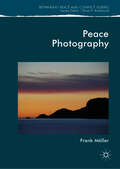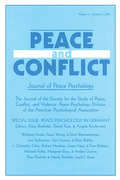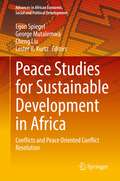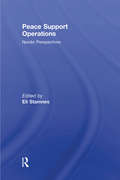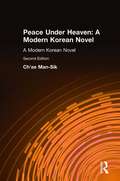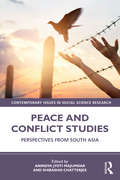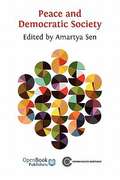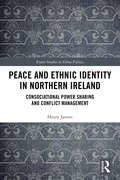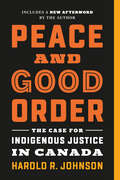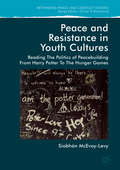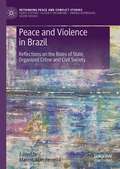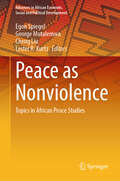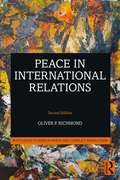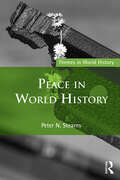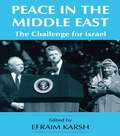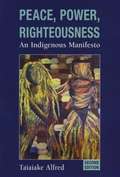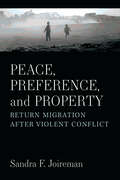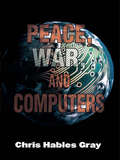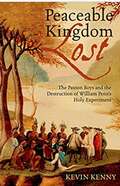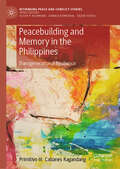- Table View
- List View
Peace Photography
by Frank MöllerThis study thinks with photography about peace. It asks how photography can represent peace, and how such representation can contribute to peace. The book offers an original critique of the almost exclusive focus on violence in recent work on visual culture and presents a completely new research agenda within the overall framework of visual peace research. Critically engaging with both photojournalism and art photography in light of peace theories, it looks for visual representations or anticipations of peace – peace or peace as a potentiality – in the work of selected photographers including Robert Capa and Richard Mosse, thus reinterpreting photography from the Spanish Civil War to current anti-migration politics in Europe. The book argues that peace photography is episodic, culturally specific, process-oriented and considerate of both the past and the future.
Peace Psychology in Germany: A Special Issue of Peace and Conflict
by Klaus Boehnke Daniel Fuss Angela KindervaterFirst published in 2005. This is a special issue of Peace and Conflict, the Journal of Peace Psychology, Volume II, number 3 looks at Peace Psychology in Germany. The papers include old and new antisemitic attitudes, human rights, attitudes towards War, refugees, and results from a German Six-Wave, twenty-year study.
Peace Studies for Sustainable Development in Africa: Conflicts and Peace Oriented Conflict Resolution (Advances in African Economic, Social and Political Development)
by Lacina YéoThis book presents a snapshot of a major challenge, and shares subjective views on various areas of conflict in Africa and the diverse – theoretical and practical – efforts to achieve peace. Following an essential review of several real-world conflict contexts on the African continent and attempts to come to terms with them critically as a first step, the book explores the lessons learned to date with regard to peace studies in Africa.
Peace Support Operations: Nordic Perspectives
by Eli StamnesPeace Support Operations: Nordic Perspectives brings together Nordic academics working in the field of peace support operations broadly defined. It contains a collection of articles that present different theoretical approaches to the study of peace support operations and contribute to enhance the knowledge of the Nordic countries’ participation in such operations. Its case studies describe the development of peacekeeping forces from Norway, Sweden, Denmark and Finland in the face of evolving threats to world security over the past sixty years, and how each country's reaction has differed. The conflicts covered in this study include the Cold War, the Balkan conflict, the first Gulf War and the Malawian ethnic conflict. Thus, it constitutes a contribution to the academic field in both a theoretical and an empirical sense. This book was previously published as a special issue of International Peacekeeping
Peace Under Heaven: A Modern Korean Novel
by Kyung-Ja Chun Man-Sik ChaeOriginally published in Seoul in 1938, soon after the outbreak of the Pacific War, "Peace Under Heaven" is a satirical novel centering on the household of a Korean landlord during the Japanese colonial occupation. Master Yun, embodying the traditional ambitions of a standard Korean paterfamilias, by being projected fast forward into a modern urban environment, caricatures the increasing irrelevance of Confucian mores to 20th-century social reality. Depicting the anomic lives of the Yun household in colonial Seoul, Chase Man-Sik, one of modern Korea's best-known writers, uses black comedy to underscore the collapse of ritualistic traditional values in the face of capitalist modernisation. The decadence of the nouveau riche pseudo-aristocrat Master Yun is interwoven with insights into the customary bases of oppression of Korean women into the self-deceptions underlying collaboration by Koreans with the Japanese oppressor. The savage hilarity of Chae's style lends force and historical relevance to his insight into the attitudes of the milieu in which his narrative is set.
Peace and Conflict Studies: Perspectives from South Asia (Contemporary Issues in Social Science Research)
by Anindya Jyoti Majumdar Shibashis ChatterjeeThis volume explores how we theorize, politicize, and practice peace and conflict discourses in the social sciences. As concepts, peace and conflict are intricately interwoven into a web of complementary discourses where states and other actors are able to negotiate, deliberate and arbitrate their differences short of the overt and covert use of physical violence. The essays in this volume reflect this eclecticism: they reflect on concerns of contemporary conflicts in world politics; the dissection of the ideas of peace and power; the way peace studies join with global agencies; peace and conflict in connection to geopolitics and identity; the domestic basis of conflict in India and the South Asian theatre including class, social cleavages and gender. Further they also process elements like globalization, media, communication and films that help us engage with the popular tropes and discursive construction of the reality that play critical roles in how peace and violence are articulated and acted upon by the elites and the masses in societies. This volume will be of great interest to scholars and researchers of political science, international relations theory, peace and conflict studies, public policy and area studies. It will also be a key resource for bureaucrats, policy makers, think tanks and practitioners working in the field of international relations.
Peace and Democratic Society
by Amartya SenRecent acts of terrorism and the current unrest in the Middle East remind us how important it is to understand the relationship between violence, peace and democracy. In a challenging and insightful essay, Amartya Sen explores ideas around 'organised violence' (such as war, genocide and terrorism) and violence against the individual. Highlighting the inadequacies of some of the widely accepted explanations for violence—including the idea that the world is experiencing a 'clash of civilisations'—Sen makes a plea for a global, multilateral debate on the causes of conflict, and an understanding of the multiple identities of the individuals involved. <p><p> The introductory essay draws on the findings of the Commonwealth Commission on Respect and Understanding, which was chaired by Sen, and established to promote mutual communication and understanding among all faiths and communities in the Commonwealth. Its timely report, "Civil Paths to Peace", suggests that governments, media and educators—indeed, everyone—must take the time to understand the complexities around violent behaviour and its causes, without prejudging what these might be.
Peace and Dialogue in a Plural Society: Contributions of the Hizmet Movement at a time of Global Tensions
by Thomas MichelIn a world that is too often seen as a cloash of civilizations, some believe there is another way, a path that involves engagement, dialogue, and respect. In Thomas Michel's new book, Peace and Dialogue in a Plural Society, he explores how Fethullah Gulen is one of those speaking most vocally in favor of a world community, where different faiths and nations can come together at one table to solve the multitude of problems facing today's world. Exploring the spiritual roots of Gulen and the Hizmet Movement, as well as drawing parallels between his own work as a Catholic priest, Michel shows how Hizmet has helped build a blueprint for intercultural communication in a time when too many voices are trying to stoke the fires of discord. Through education, dialogue, and a respect for basic human dignity, Michel finds a foundation in Gulen's faith and Hizmet's service upon which a healthy, diverse society can be built.
Peace and Ethnic Identity in Northern Ireland: Consociational Power Sharing and Conflict Management (Exeter Studies in Ethno Politics)
by Henry JarrettConsociational power sharing is often perceived to be the method of conflict management that is most likely to succeed in deeply divided societies. The case of Northern Ireland in particular is heralded by many as a consociational success story. Since the signing of the Good Friday (Belfast) Agreement in 1998, significant conflict transformation has taken place in the form of a considerable reduction in levels of violence and the establishment of power sharing between unionists and nationalists. This book looks at what consociational power sharing achieves after its implementation – specifically, whether it can work to overcome existing identities in divided societies, or whether it simply freezes divisions. It argues that if consociational power sharing is facilitating a move towards a genuinely shared society, this would be demonstrated in the focus of the election campaigns of Northern Ireland’s political parties, which would be almost exclusively based around socio-economic issues affecting the whole population, rather than narrow single identity concerns. However, the book claims that, on the whole, this has not been realised. Although election campaigns are today less strident than they were in the pre-1998 era, it remains the case that they usually foreground single identity symbolism, as it is this that resonates with voters. Whilst consociational power sharing has been very successful in reducing levels of violent conflict and facilitating elite level cooperation between unionists and nationalists, it has been much less successful in reducing divisions within wider society to facilitate a genuinely shared Northern Irish identity. By establishing an important middle ground between consociational proponents and critics, this research will be of significant interest to students and scholars of ethnic politics, political sociology, conflict management, and divided societies more generally.
Peace and Good Order: The Case for Indigenous Justice in Canada
by Harold R. JohnsonAn urgent, informed, intimate condemnation of the Canadian state and its failure to deliver justice to Indigenous people by national bestselling author and former Crown prosecutor Harold R. Johnson."The night of the decision in the Gerald Stanley trial for the murder of Colten Boushie, I received a text message from a retired provincial court judge. He was feeling ashamed for his time in a system that was so badly tilted. I too feel this way about my time as both defence counsel and as a Crown prosecutor; that I didn't have the courage to stand up in the court room and shout 'Enough is enough.' This book is my act of taking responsibility for what I did, for my actions and inactions." --Harold R. JohnsonIn early 2018, the failures of Canada's justice system were sharply and painfully revealed in the verdicts issued in the deaths of Colten Boushie and Tina Fontaine. The outrage and confusion that followed those verdicts inspired former Crown prosecutor and bestselling author Harold R. Johnson to make the case against Canada for its failure to fulfill its duty under Treaty to effectively deliver justice to Indigenous people, worsening the situation and ensuring long-term damage to Indigenous communities. In this direct, concise, and essential volume, Harold R. Johnson examines the justice system's failures to deliver "peace and good order" to Indigenous people. He explores the part that he understands himself to have played in that mismanagement, drawing on insights he has gained from the experience; insights into the roots and immediate effects of how the justice system has failed Indigenous people, in all the communities in which they live; and insights into the struggle for peace and good order for Indigenous people now.
Peace and Resistance in Youth Cultures
by Siobhan McEvoy-LevyThis book offers a rationale for and ways of reading popular culture for peace. It argues that we can improve peacebuilding theory and practice through examining popular culture's youth revolutionaries and their outcomes - from their digital and plastic renderings to their living embodiments in local struggles for justice. The study combines insights from post-structural, post-colonial, feminist, youth studies and peace and conflict studies theories to analyze the literary themes, political uses, and cultural impacts of two hit book series - Harry Potter and The Hunger Games - tracing how these works have been transformed into visible political practices, including social justice advocacy and government propaganda in the War on Terror. Pop culture production and consumption help maintain global hierarchies of inequality and structural violence but can also connect people across divisions through fandom participation. Including chapters on fan activism, fan fiction, Guantanamo Bay detention center, youth as a discursive construct in IR, and the merchandizing and tourism opportunities connected with The Hunger Games, the book argues that through taking youth-oriented pop culture seriously, we can better understand the local, global and transnational spaces, discourses, and the relations of power, within which meanings and practices of peace are known, negotiated, encoded and obstructed.
Peace and Security in Northeast Asia: Nuclear Issue and the Korean Peninsula
by Peter Hayes Young Whan KihlThis work provides an analysis of North Korea's nuclear controversy from a variety of perspectives, including: nuclear reactor technology and technology transfer; economic sanctions and incentives; confidence-building measures; environmental challenges; and the views of Korea and the major powers.
Peace and Violence in Brazil: Reflections on the Roles of State, Organized Crime and Civil Society (Rethinking Peace and Conflict Studies)
by Marcos Alan FerreiraThis edited volume examines how the multiple manifestations of social violence in Brazil impacts the building of a peaceful society. The chapters reflect on the role of state, organized crime and civil society. They provide a unique analysis of how the Brazilian state deals with criminal violence, but also finds challenges to comply with Sustainable Development Goal 16, to interdict police violence, and to provide an efficient gun policy. The book shows the agency of civil society in a violent society, in which NGOs and communities engage in key peace formation action, including advocacy for human rights and promoting arts. The overall aim of this book is to advance the research agenda regarding the intersections between peace, public security, and violence, under the lens of peace studies. In Brazil, the challenges to peace differ markedly from areas in regular conflict.
Peace as Nonviolence: Topics in African Peace Studies (Advances in African Economic, Social and Political Development)
by Cheng Liu Lester R. Kurtz Egon Spiegel George MutalemwaThis book advances the peace discourse as defined in UN guidelines, while also working towards the implementation of the science of peace in various educational contexts in Africa, particularly at universities. The contributions gathered here are intended to highlight the role of university peace studies programs, particularly their relevance for peace education, peace research and peace work.The book is dedicated to students and teachers of Peace Studies and Development Studies at universities as well as civil society experts. They bear a great responsibility with regard to shaping the “Culture of Peace” called for by the UN, based on the foundation of peace education and peace work and in the context of an adequate peace policy. The book seeks to strengthen African pillars of lasting peace through Peace Studies. Analyzing the latest topics in Africa of universal importance, it offers a valuable reference guide for researchers and professionals grappling with the realities of nonviolence and other essential topics in Peace Studies.
Peace at Last: A Portrait of Armistice Day, 11 November 1918
by Guy CuthbertsonA vivid, intimate hour-by-hour account of Armistice Day 1918, including photographs: “A pleasure to read . . . full of fascinating tidbits.” —The Wall Street JournalThis is the first book to focus on the day the armistice was signed between the Allies and Germany, ending World War I. In this rich portrait of Armistice Day, which ranges from midnight to midnight, Guy Cuthbertson brings together news reports, photos, literature, memoirs, and letters to show how the people on the street, as well as soldiers and prominent figures like D. H. Lawrence and Lloyd George, experienced a strange, singular day of great joy, relief, and optimism—and examines how Britain and the wider world reacted to the news of peace.“[A] brilliant portrayal of Britain on the day that peace broke out; when people could believe there was an end to the war to end all wars. He weaves a wonderful tapestry of the mood and events across the country, drawing on a wide range of local and regional newspapers . . . accessible history at its best . . . outstanding.” —The Evening Standard
Peace in International Relations (Routledge Studies in Peace and Conflict Resolution)
by Oliver P. RichmondThis updated and revised second edition examines the conceptualisation and evolution of peace in International Relations (IR) theory. The book examines the concept of peace and its usage in the main theoretical debates in IR, including realism, liberalism, constructivism, critical theory and post-structuralism, as well as in the more direct debates on peace and conflict studies. It explores themes relating to culture, development, agency and structure, not just in terms of representations of international relations, and of peace, but in terms of the discipline of IR itself. The work also specifically explores the recent mantras associated with liberal and neoliberal versions of peace, which appear to have become foundational for much of the mainstream literature in IR and for doctrines for peace and development in the policy world. Analysing war has often led to the dominance - and mitigation - of violence as a basic assumption in, and response to, the problems of international relations. This study aims to redress this negative balance by arguing that IR offers a rich basis for the study of peace, which has advanced significantly over the last century or so. It also proposes innovative theoretical dimensions of the study of peace in IR, with new chapters discussing post-colonial and digital developments in the discipline. This book will be of great interest to students of peace and conflict studies, politics and International Relations.
Peace in World History (Themes in World History)
by Peter N. StearnsIn Peace in World History, Peter N. Stearns examines the ideas of peace that have existed throughout history, and how societies have sought to put them into practice. Beginning with the status of peace in early hunter-gatherer and agricultural societies, and continuing through the present day, the narrative gives students a clear view of the ways people across the world have understood and striven to achieve peace throughout history. Topics covered include: Comparison of the ‘pax Romana’ and ‘pax Sinica’ of Rome and China Concepts of peace in Buddhism, Christianity, and Islam, and their historical impact The place of peace in the periods of expanding empires The emergence, starting in the 19th century, of formal schemes to promote peace amid increasingly destructive technologies for warfare Moving away from the view of history as a series of military conflicts, Peace in World History offers a new way of looking at world history by focusing on peace. Showing how concepts of peace have evolved over time even as they have been challenged by war and conflict, this lively and engaging narrative enables students to consider peace as a human possibility.
Peace in World History (Themes in World History)
by Peter StearnsIn Peace in World History, Peter N. Stearns examines the ideas of peace that have existed throughout history, and how societies have sought to put them into practice. Beginning with the status of peace in early hunter-gatherer and agricultural societies, and continuing through the present day, the narrative gives students a clear view of the ways people across the world have understood and striven to achieve peace throughout history. Topics covered include: Comparison of the ‘pax Romana’ and ‘pax Sinica’ of Rome and China Concepts of peace in Buddhism, Christianity, and Islam, and their historical impact The place of peace in the periods of expanding empires The emergence, starting in the 19th century, of formal schemes to promote peace amid increasingly destructive technologies for warfare Moving away from the view of history as a series of military conflicts, Peace in World History offers a new way of looking at world history by focusing on peace. Showing how concepts of peace have evolved over time even as they have been challenged by war and conflict, this lively and engaging narrative enables students to consider peace as a human possibility.
Peace in the Middle East: The Challenge for Israel (Israeli History, Politics and Society)
by Efraim KarshSpecialists from Israel, Europe and the US examine the implications of peace for Israel. How would it affect the country's political and economic systems and its national security, and what would peace mean for its regional and international standing and its relations with world Jewry?
Peace, Power, Righteousness (Second Edition): An Indigenous Manifesto
by Taiaiake AlfredThis manifesto calls for the indigenous peoples of North America to move beyond their 500-year history of pain, loss, and colonization, and move forward to the reality of self-determination. This new edition of Alfred's important manifesto is thoroughly updated in the context of current issues related to government policy and First Nations politics today. In addition to new examples of indigenous-state relations, it includes the latest court cases and updated evaluations of key negotiations over land and self-government. A new preface incorporates an original, previously unpublished dialogue with the influential Dakota author, historian, and activist Vine Deloria Jr, recorded shortly before his death in 2005.
Peace, Preference, and Property: Return Migration after Violent Conflict
by Sandra F JoiremanGrowing numbers of people are displaced by war and violent conflict. In Ukraine, Afghanistan, Ethiopia, Myanmar, Syria, and elsewhere violence pushes civilian populations from their homes and sometimes from their countries, making them refugees. In previous decades, millions of refugees and displaced people returned to their place of origin after conflict or were resettled in countries in the Global North. Now displacements last longer, the number of people returning home is lower, and opportunities for resettlement are shrinking. More and more people spend decades in refugee camps or displaced within their own countries, raising their children away from their home communities and cultures. In this context, international policies encourage return to place of origin. Using case studies and first-person accounts from interviews and fieldwork in post-conflict settings such as Uganda, Liberia, and Kosovo, Sandra F. Joireman highlights the divergence between these policies and the preferences of conflict-displaced people. Rather than looking from the top down, at the rights that people have in international and domestic law, the perspective of this text is from the ground up—examining individual and household choices after conflict. Some refugees want to go home, some do not want to return, some want to return to their countries of origin but live in a different place, and others are repatriated against their will when they have no other options. Peace, Preference, and Property suggests alternative policies that would provide greater choice for displaced people in terms of property restitution and solutions to displacement.
Peace, War and Computers
by Chris Hables GrayComputers are at the heart of war as we know it and this visionary overview of cyber war in the twenty-first century studies how electronics have changed the way we fight. Using informatics and chaos theory, this is a disarming, yet enthralling read.
PeaceJam: A Billion Simple Acts of Peace
by Ivan Suvanjieff Dawn Gifford EngleThe Dalai Lama, the Archbishop Desmond Tutu, Costa Rican president Oscar Arias and political rights activist Aung San Suu Kyi are just some of the Nobel Peace Laureates who have joined the PeaceJam Foundation in their Global Call to Action. <P><P>This book profiles all of these laureates and their work with teens around the world as they combine forces to help stop the spread of disease, promote women?s rights, provide equitable access to food and water, and more. Combining profiles of the laureates? including personal bios?heartwarming tales of the youth and their projects, and tips on how readers can get involved, this is a comprehensive guide to the PeaceJam Foundation. Both humbling and inspiring, PeaceJam: A Billion Simple Acts of Peace is sure to excite anyone who picks it up to think about simple ways to help make our world a better place.
Peaceable Kingdom Lost: The Paxton Boys and the Destruction of William Penn's Holy Experiment
by Kevin KennyWilliam Penn established Pennsylvania in 1682 as a "holy experiment" in which Europeans and Indians could live together in harmony. In this book, historian Kevin Kenny explains how this Peaceable Kingdom--benevolent, Quaker, pacifist--gradually disintegrated in the eighteenth century, with disastrous consequences for Native Americans. <p><p> Kenny recounts how rapacious frontier settlers, most of them of Ulster extraction, began to encroach on Indian land as squatters, while William Penn's sons cast off their father's Quaker heritage and turned instead to fraud, intimidation, and eventually violence during the French and Indian War. In 1763, a group of frontier settlers known as the Paxton Boys exterminated the last twenty Conestogas, descendants of Indians who had lived peacefully since the 1690s on land donated by William Penn near Lancaster. Invoking the principle of "right of conquest," the Paxton Boys claimed after the massacres that the Conestogas' land was rightfully theirs. They set out for Philadelphia, threatening to sack the city unless their grievances were met. A delegation led by Benjamin Franklin met them and what followed was a war of words, with Quakers doing battle against Anglican and Presbyterian champions of the Paxton Boys. The killers were never prosecuted and the Pennsylvania frontier descended into anarchy in the late 1760s, with Indians the principal victims. The new order heralded by the Conestoga massacres was consummated during the American Revolution with the destruction of the Iroquois confederacy. At the end of the Revolutionary War, the United States confiscated the lands of Britain's Indian allies, basing its claim on the principle of "right of conquest." <p><p> Based on extensive research in eighteenth-century primary sources, this engaging history offers an eye-opening look at how colonists--at first, the backwoods Paxton Boys but later the U.S. government--expropriated Native American lands, ending forever the dream of colonists and Indians living together in peace.
Peacebuilding and Memory in the Philippines: Transgenerational Resilience (Rethinking Peace and Conflict Studies)
by Primitivo III RagandangThis book critically examines community resilience within peace and conflict studies. By focusing on the complexities of resilience in the ayóm-ayómic political order in the Philippines, it shows how memories, experiences and intergenerational dialogue shape resilience strategies across time and space. Through theoretical analysis and case studies, the book challenges conventional understandings of resilience by highlighting its complex intersections with agency, resistance, and political survival. It delves into the role of resource scarcity, trauma, and shifting socio-political landscapes in shaping resilience strategies, offering a nuanced perspective beyond its often-romanticized portrayal. By bridging theoretical debates with real-world insights, it provides a fresh framework for understanding resilience as both a political and social process. This book is an essential resource for scholars, practitioners, and policymakers engaged in peacebuilding, governance, and conflict transformation.
